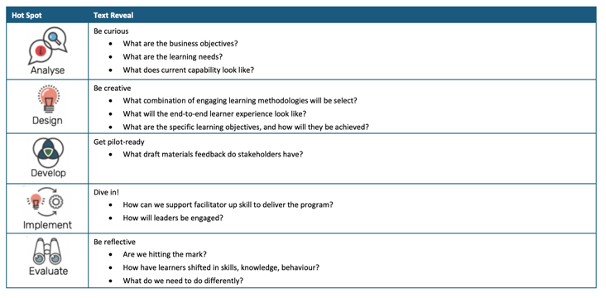eLearning Developer Perth
eLearning Developer Perth
What is an eLearning Developer?
An eLearning Developer in Perth creates online programs using authoring tools. These may include Articulate 360 (Rise 360 or Storyline 360), iSpring Suite, iSpring Page or Adobe Captivate.
Typically, eLearning Developers are provided a storyboard, developed by an Instructional Designer or a Learning Designer. A storyboard is essentially a ‘blueprint’ of the course, which outlines the program’s structure, flow, instruction and the content to be included. See the following example.



Our eLearning Developer in Perth then transfer the storyboard into eLearning using an authoring tool such as include Articulate 360 (Rise 360 or Storyline 360), iSpring Suite, iSpring Page or Adobe Captivate. Their role to ensure the course is visually appealing, interactive, engaging and delivered effectively.
Whilst you don’t require a qualification to become an eLearning Developer, many have a bachelor’s degree.
eLearning Developers in Perth often have additional experience and skills, such as:
- Graphic design
- Photoshop
- Developing accessible eLearning programs, compliant with Web Content Accessibility Guidelines (WCAG) 2.0
How much to eLearning Developers make?
An eLearning Developer’s income varies. It can depend on their education, level of experience, number of years in the field, capabilities in using a variety of authoring tools and additional skills (such as graphic design) that enhance eLearning.
According to Salary.com, the average eLearning Development salary in Australia in 2021 is approx. $98,000!
What is the difference between an Instructional Designer and an eLearning Developer?
An Instructional Designer’s role is far more diverse than that of eLearning course Developers. They use an instructional design model, such as the ADDIE model of instructional design, to identify learning needs and design a learning solution. Instructional Designers determine the learning outcomes, delivery methods, duration, learning methodologies, activities, and pre and post learning experiences. They also design the evaluation tools to measure whether the program hits its objectives.
Instructional Designers ensure the programs are designed to develop the skills, knowledge and behaviours required to achieve the desired learning outcome. To do this, they draw on instructional design principles (such as Merrill’s First Principles of Instruction) and principles of adult learning for best practice. With the help of subject matter experts (SMEs), Instructional Designers create the content and design instruction using a storyboard template. Once complete, they hand the ‘blueprint’ or ‘script’ over to the eLearning Developer.
eLearning Developers bring the storyboard to life! They transfer the content and instruction into eLearning using the relevant authoring tool.
Firstly, they review the storyboard and identify any elements that may need to be tweaked. Since Instructional Designers don’t typically produce eLearning, they may not be familiar with the capabilities of each authoring tool. Therefore, the eLearning Developer need to raise these potential issues with the Instructional Designers. They’ll then collaborate to adjust the interactions and ensure they function appropriately in the eLearning environment.
The eLearning Developer produces the eLearning program. The eLearning Developer and Instructional Designers work together to action client feedback, with the Instructional Designer responding to changes to the instructional content and the eLearning Developer handing changes to functionality.
How long does it take to develop 1 hour of eLearning?
The time it takes to develop eLearning solutions will vary, depending on a number of factors. Template requirements, volume of materials to be developed, your experience, the complexity of interactivity and familiarity with eLearning authoring tools are all critical factors.
Elearning content development timeframes vary depending on the complexity of the program – the greater the complexity, the longer it takes to create. Factors that influence complexity (and timeframes) include:
- Game-based design – branching or linear
- Types of media and simulations
- Types of evaluations and assessment methods
- Detail of graphics (e.g. 2D or 3D)
A survey conducted in 2020 showed the average time to produce (including analyse, design and develop) one hour of learning are as follows:*
| Delivery Method | Time to produce 1 hour of learning (Hrs) |
| Online Instructor-Led | 132 |
| eLearning Level 1 – Passive | 48 |
| eLearning Level 2 – Limited | 193 |
| eLearning Level 3 – Complex | 348 |
| eLearning Level 4 – Real-Time | 542 |
In reality, you are unlikely to have such generous amounts of time available to you!
How, then, can you provide a ‘palatable’ estimate of time to the business?
The study found the following key barriers to productivity:*
- Limited resources
- Scope creep
- Lack of availability of SMEs
- Limited skills
- Lack of accountability
By eliminating these barriers, you’ll increase your productivity and reduce your time to develop eLearning. This means you’ll be able to offer a great service at competitive prices!
*Source: Defelice, R., (13 January 2021). How Long Does It Take to Develop Training? New Question, New Answers. Retrieved from https://www.td.org/insights/how-long-does-it-take-to-develop-training-new-question-new-answers



